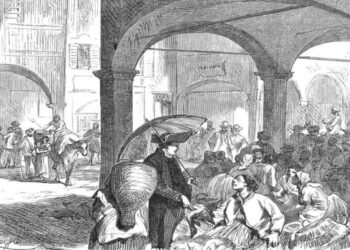San Francisco, renowned for its iconic landmarks and vibrant culture, is often scrutinized for its crime rate. As a city with a rich history and diverse population, understanding the intricacies of its crime landscape is crucial. However, merely assessing San Francisco’s isolated crime rate provides limited insights. To gain a comprehensive understanding, comparing its crime statistics with other major cities is imperative. This article embarks on a journey to delve into the depths of San Francisco’s crime rate, juxtaposing it against other urban centers. Through this comparative analysis, we aim to unravel the complexities of crime dynamics, deciphering the realities beyond mere perceptions.
Brief Overview Of San Francisco’s Reputation For Crime
While celebrated for its picturesque vistas and progressive ethos, San Francisco grapples with a reputation for crime that often looms over its cultural allure. Here’s a detailed overview of its standing:
San Francisco’s history is peppered with tales of lawlessness, tracing back to the Gold Rush era when the city burgeoned with fortune seekers. The resulting influx of people and the absence of structured law enforcement birthed a raucous environment ripe for criminal activity.
Over the decades, San Francisco has contended with a spectrum of criminal challenges, ranging from street-level theft and drug-related offenses to more serious crimes like assault and homicide. Despite efforts to curb crime, specific neighborhoods have struggled with persistent issues, perpetuating the city’s reputation for lawlessness in some quarters.
A notable contributor to San Francisco’s crime narrative is its visible homelessness crisis and stark economic disparities. The juxtaposition of extreme wealth alongside pervasive poverty has created a socioeconomic landscape where survival-driven crimes, such as petty theft and drug offenses, are prevalent among marginalized communities.
In recent years, San Francisco has grappled with a surge in property crimes, including car break-ins and thefts. The city’s tourist hubs and densely populated neighborhoods have become hotspots for opportunistic criminals, fueling concerns among residents and visitors alike about the safety of their belongings.
Law enforcement in San Francisco faces unique challenges inherent to urban policing. Balancing proactive crime prevention with community engagement initiatives requires a delicate dance, particularly in fostering trust within communities that distrust law enforcement due to historical tensions and social justice movements.
San Francisco’s crime woes often attract significant media attention, further amplifying its reputation for lawlessness. While media coverage sheds light on critical issues, it can also perpetuate stereotypes and misconceptions, shaping public perceptions of safety in the city.
Crime Rates In comparison To Other Cities
When examining San Francisco’s crime rates in comparison to other cities, several key points emerge:
Diverse Comparison Pool: To provide a comprehensive assessment, it is crucial to compare San Francisco’s crime rates with those of a diverse selection of major cities. This includes metropolises with comparable population sizes, urban demographics, and economic profiles. New York City, Los Angeles, Chicago, and Seattle often serve as reference points due to their status as prominent urban centers facing similar challenges.
Per Capita Analysis: Merely comparing raw crime numbers between cities can be misleading due to variations in population size. Utilizing per capita crime rates, which normalize crime statistics based on population, offers a more accurate basis for comparison. This approach ensures a fair assessment of the prevalence and severity of crime relative to the size of each city’s population.
Understanding Crime Dynamics: Each city has unique socio-economic, demographic, and geographic characteristics influencing its crime landscape. Factors such as poverty rates, unemployment levels, racial composition, and residential segregation can significantly impact crime rates. Analyzing how these variables interact with law enforcement strategies and community dynamics provides insights into the underlying drivers of crime in different urban contexts.
Varied Crime Categories: Crime manifests in various forms, encompassing violent offenses and property crimes. Comparing San Francisco’s crime rates with those of other cities involves examining multiple crime categories, including homicide, robbery, burglary, and vehicle theft. Disparities in crime patterns across different cities shed light on localized crime trends and law enforcement priorities.
Temporal Analysis: Crime rates are dynamic and subject to fluctuations over time. Conducting a longitudinal analysis allows for assessing trends and patterns in crime rates within San Francisco and comparative cities. Identifying whether crime rates are increasing, decreasing, or stabilizing provides valuable insights into the efficacy of crime prevention measures and the broader socio-economic environment’s impact on crime dynamics.
Policy Implications: Comparing San Francisco’s crime rates to those of other cities facilitates a better understanding of its relative standing and informs policy-making and resource allocation decisions. Identifying successful strategies implemented in other cities can inspire innovative approaches to crime reduction while recognizing shared challenges fosters collaboration and knowledge exchange among urban centers grappling with similar issues.
What Factors Influencing Crime Rates?
Several factors influence crime rates, shaping the complex dynamics of criminal activity within a community. Depending on the specific socio-economic, cultural, and geographical context, these factors can vary in significance and interplay. Here are some key factors:
Socio-Economic Conditions:
Poverty, unemployment, and lack of access to quality education and economic opportunities are strongly correlated with higher crime rates. Economic deprivation can drive individuals towards criminal behavior as a means of survival or as a response to systemic inequalities.
Demographic Composition:
Demographic factors such as age, gender, and ethnicity shape crime rates. Young males, particularly those in their late teens and early twenties, are statistically more likely to engage in criminal activity. Additionally, societal disparities and discrimination based on race and ethnicity can contribute to differential involvement in crime.
Community Disorganization:
Social disorganization, characterized by weakened social bonds, breakdown of traditional social control mechanisms, and lack of community cohesion, can create fertile ground for criminal activity. Communities experiencing high rates of residential mobility, family instability, and social isolation are particularly vulnerable to crime.
Drug and Alcohol Abuse:
Substance abuse, including the use of illicit drugs and excessive alcohol consumption, is closely linked to various forms of criminal behavior, such as drug trafficking, property crimes to support addiction, and violent confrontations under the influence.
Urbanization and Population Density:
Urban areas tend to have higher crime rates than rural areas due to factors such as population density, anonymity, and the presence of diverse socioeconomic groups. Concentrated urban poverty, inadequate housing, and limited access to social services exacerbate crime risks in densely populated areas.
Law Enforcement Practices:
The effectiveness of law enforcement strategies and practices can influence crime rates. Proactive policing, community-oriented policing, and targeted interventions aimed at high-crime areas can deter criminal activity and enhance public safety. Conversely, issues such as police misconduct, bias, and lack of trust between law enforcement and the community can undermine crime prevention efforts.
Cultural and Social Norms:
Cultural attitudes towards violence, crime, and law enforcement can shape individuals’ perceptions of acceptable behavior and influence their likelihood of engaging in criminal acts. Social norms that condone or glorify criminal behavior can contribute to a culture of crime within specific communities.
Legislative and Policy Frameworks:
Legal frameworks, criminal justice policies, and sentencing practices can impact crime rates by influencing deterrence, punishment, and rehabilitation. Policies addressing root causes of crime, such as poverty alleviation, education reform, and access to mental health services, can contribute to long-term crime reduction strategies.
Strategies For Addressing Crime Issues In San Francisco And Other Cities
Addressing crime issues in San Francisco and other cities requires a multifaceted approach that integrates various prevention, intervention, enforcement, and community engagement strategies. Here are some key strategies:
- Community Policing: Implementing community-oriented policing approaches prioritizing collaboration between law enforcement agencies and local communities. Building trust, fostering positive relationships, and empowering communities to participate actively in crime prevention efforts can enhance public safety and address underlying social issues.
- Targeted Enforcement: Deploying targeted law enforcement efforts to address high-crime areas and hotspots. Utilizing data-driven analysis and intelligence-led policing techniques to identify crime trends, patterns, and emerging threats enables law enforcement agencies to allocate resources effectively and respond proactively to criminal activity.
- Investment in Social Services: Investing in social services and community-based programs that address root causes of crime, such as poverty, homelessness, substance abuse, and mental health issues. Access to affordable housing, job training, education, healthcare, and support services can reduce vulnerabilities and prevent individuals from engaging in criminal behavior.
- Youth Engagement and Education: Implementing youth-oriented crime prevention initiatives that promote positive youth development, mentorship, and educational opportunities. Investing in after-school programs, youth employment initiatives, recreational activities, and outreach programs can steer at-risk youth away from delinquency and crime.
- Restorative Justice Programs: Supporting restorative justice approaches emphasizing accountability, reconciliation, and healing for victims and offenders. Restorative justice practices, such as victim-offender mediation, community conferencing, and restitution programs, offer alternative pathways to traditional criminal justice responses and promote rehabilitation and reintegration.
- Gun Violence Prevention: Implementing evidence-based strategies to address gun violence and reduce firearms-related crime. This includes enacting common-sense gun laws, implementing gun buyback programs, promoting responsible gun ownership, and supporting violence intervention initiatives that target at-risk individuals and communities.
- Collaborative Partnerships: Fostering collaborative partnerships among government agencies, law enforcement, community organizations, faith-based groups, businesses, and residents. Engaging diverse stakeholders in coordinated efforts to address crime fosters collective ownership of community safety and enables the sharing resources, expertise, and best practices.
- Crime Prevention through Environmental Design (CPTED): CPTED principles can be incorporated into urban planning, architecture, and community development to create safer, more secure environments. Designing public spaces, buildings, and neighborhoods to deter crime, enhance natural surveillance, and promote social interaction can contribute to crime prevention and community well-being.
- Trauma-Informed Approaches: Adopting trauma-informed approaches to crime prevention and victim support that recognize the impact of trauma on individuals and communities affected by crime. Providing trauma-informed care, mental health services, and support systems for victims, survivors, and perpetrators of crime can facilitate healing and prevent cycles of violence.
- Public Awareness and Education: Raising public awareness about crime prevention strategies, safety tips, and resources available to community members. Educating residents about crime trends, risk factors, and protective measures empowers individuals to take proactive steps to enhance their safety and contribute to community resilience.
Final Thoughts
Addressing crime issues in cities like San Francisco requires a multifaceted approach that combines proactive policing, community engagement, investment in social services, and collaborative partnerships. By addressing root causes, promoting positive youth development, and fostering restorative justice, cities can create safer, more resilient communities where all residents can thrive. Through collective action and sustained commitment, we can work towards a future where crime rates decline and the quality of life improves for everyone.
FAQ’s
What are the most common crimes in San Francisco?
Common crimes in San Francisco include property crimes such as theft, burglary, and vehicle break-ins, as well as drug-related offenses and certain types of violent crimes like assault. Crime trends vary by neighborhood and can be influenced by socioeconomic factors and law enforcement strategies.
How does San Francisco’s crime rate compare to New York City?
Comparing crime rates between San Francisco and New York City involves analyzing population density, demographics, and law enforcement practices. While both cities are major urban centers, they may experience different crime patterns and trends.
What measures is San Francisco taking to reduce crime?
San Francisco employs various strategies to reduce crime, including community policing, targeted law enforcement efforts, investment in social services, and collaborative partnerships with community organizations. These efforts aim to address the root causes of crime and enhance public safety.







